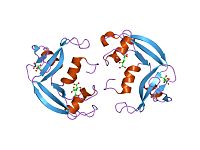
Photo from wikipedia
Background: 5-Oxo-6,8,11,14-eicosatetraenoic acid (5-oxo-ETE) is a potent eosinophil chemoattractant and activator that is synthesized not only in inflammatory cells but also in bronchial epithelial cells. The purpose of this study… Click to show full abstract
Background: 5-Oxo-6,8,11,14-eicosatetraenoic acid (5-oxo-ETE) is a potent eosinophil chemoattractant and activator that is synthesized not only in inflammatory cells but also in bronchial epithelial cells. The purpose of this study is to clarify whether 5-oxo-ETE can promote the production of eosinophil cation protein (ECP) by eosinophils in nasal polyps (NP) in vitro, and whether normal nasal epithelial cells can produce this lipid mediator in response to oxidative stress. Materials and Methods: Nasal biopsy samples were obtained from normal subjects or subjects with chronic rhinosinusitis with NP. The infiltration of eosinophil in NP was detected and cultured. After that, concentrations of ECP in eosinophil and NP cultures were evaluated after the treatment of 5-oxo-ETE or 5-oxo-ETE + its receptor (OXER) antagonist, pertussis toxin (PT). Then we studied the synthesis of 5-oxo-ETE after H2O2 stimulation by normal nasal epithelial cells and by epithelial cells of NP alone in the cultures, and also determined the OXER expression in NP. Results: The number of infiltrative eosinophils in NP was increased. The ECP levels in eosinophil and NP cultures were enhanced after the administration of 5-oxo-ETE, and decreased by the PT treatment. 5-Oxo-ETE was upregulated in the cultures of nasal epithelial cells in the presence of H2O2 and of NP epithelial cells alone. The OXER was expressed in inflammatory cells, and not in epithelial cells. Conclusion: 5-Oxo-ETE produced by nasal epithelial cells may play a role in the formation and development of NP.
Journal Title: International Archives of Allergy and Immunology
Year Published: 2018
Link to full text (if available)
Share on Social Media: Sign Up to like & get
recommendations!